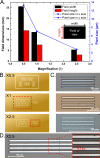Rapid mask prototyping for microfluidics
- PMID: 27014396
- PMCID: PMC4788606
- DOI: 10.1063/1.4943124
Rapid mask prototyping for microfluidics
Abstract
With the rise of microfluidics for the past decade, there has come an ever more pressing need for a low-cost and rapid prototyping technology, especially for research and education purposes. In this article, we report a rapid prototyping process of chromed masks for various microfluidic applications. The process takes place out of a clean room, uses a commercially available video-projector, and can be completed in less than half an hour. We quantify the ranges of fields of view and of resolutions accessible through this video-projection system and report the fabrication of critical microfluidic components (junctions, straight channels, and curved channels). To exemplify the process, three common devices are produced using this method: a droplet generation device, a gradient generation device, and a neuro-engineering oriented device. The neuro-engineering oriented device is a compartmentalized microfluidic chip, and therefore, required the production and the precise alignment of two different masks.
Figures






References
-
- Xia Y. and Whitesides G. M., Annu. Rev. Mater. Sci. 28, 153 (1998).10.1146/annurev.matsci.28.1.153 - DOI
-
- Wang T., Quaglio M., Pirri F., Cheng Y.-C., Busacker D., and Cerrina F., Proc. SPIE 7274, 727420 (2009).10.1117/12.814831 - DOI
-
- Chung S. E., Park W., Park H., Yu K., Park N., and Kwon S., Appl. Phys. Lett. 91, 41106 (2007).10.1063/1.2759988 - DOI
LinkOut - more resources
Full Text Sources
Other Literature Sources
Miscellaneous
